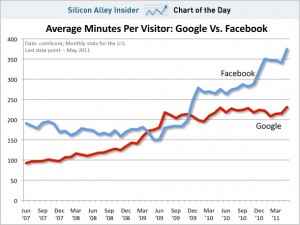From Businessinsider we get the graph below. Data are from comscore and show the monthly stats of time spent inside Facebook for U.S. users versus Google (June 2011). People spend a tremendous time in Facebook. And to be fair, Google is sending you to other sites, while Facebook provides an intranet of webpages. Comscore reports in May that among the top web properties in US (in terms of unique visitors) Google ranks second and Facebook fourth. Another statistic from comeScore is U.S. Online Display Advertising Market Delivers 1.1 Trillion Impressions in Q1 2011 and Facebook led this one.
Overall, the social component is more and more important and Google has not (yet) been able to challenge Facebook in this domain. Orkut, Google Open Social, Wave, Buzz have been attempts but not successful.
But today we have the announcement of a new social era for Google, Google+. From the blog article:
Among the most basic of human needs is the need to connect with others. With a smile, a laugh, a whisper or a cheer, we connect with others every single day.
Today, the connections between people increasingly happen online. Yet the subtlety and substance of real-world interactions are lost in the rigidness of our online tools.
In this basic, human way, online sharing is awkward. Even broken. And we aim to fix it.
We’d like to bring the nuance and richness of real-life sharing to software. We want to make Google better by including you, your relationships, and your interests.
The set of services that create a comprehensive social experience are:
- +Circles: share what matters, with the people who matter most
- +Sparks: strike up a conversation, about pretty much anything
- +Hangouts: stop by and say hello, face-to-face-to-face
- +Mobile: share what’s around, right now, without any hassle
- +Location, location, location
- +Instant Upload
- +Huddle
- +You: putting you first, all across Google
plus.google.com is the official page of this project, at the moment by invitation only.
The best and most comprehensive public report on this project, called inside Google Emerald Sea, is from Steven Levy on Wired, Inside Google+ — How the Search Giant Plans to Go Social.
Other early reports from the press are:
- Google Steps Up Attack on Facebook’s Turf WSJ
- Google Introduces Facebook Competitor, Emphasizing Privacy NYT
- Google Launches Google+ To Battle Facebook Mashable
- Google goes social with Google+ — Will Facebook flinch? SocialBeat
- Google+ for Android Is Like Having Facebook, iCloud and GroupMe in One App Gizmodo
- Google+ invite received, we go hands-on Engdaget
- Why Google+ Looks Good: Original Macintosh Team Member Andy Hertzfeld TechCrunch

